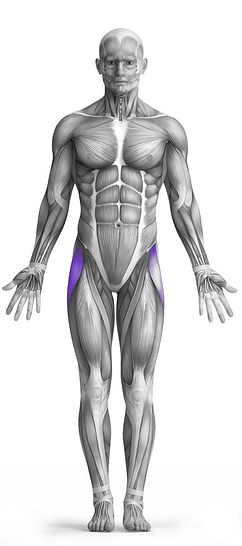Standing Hip Flexion w/ Bands 101 Video Tutorial
0

Exercise Synopsis
Target Muscle Group
Hip Flexors
Secondary Targets
None
Execution
Compound
Force Type
Pull (Unilateral)
Required Equipment
Band
Fitness Level
Beginner
Variations
None
Alternatives
None
Timer
Hour
Minute
Second
Stopwatch
00:00:00:00
Overview
The "Standing Hip Flexion with Bands" exercise targets the hip flexors by using resistance bands to create tension as you lift your leg. This movement focuses on strengthening the muscles responsible for flexing the hip, which play a key role in walking, running, and various athletic movements. To perform the exercise, attach a resistance band to a sturdy surface at ankle height, stand tall, and place one foot inside the band. As you stand upright, lift the banded leg straight in front of you, keeping your knee slightly bent, then slowly lower it back down. This exercise can improve hip flexor strength and mobility, benefiting overall lower body function.
How to Perform
Begin by standing upright with a resistance band securely looped around one foot and your arms relaxed at your sides.
Engage your core and maintain a neutral spine throughout the movement.
Inhale to prepare, then exhale as you lift your knee straight in front of you, focusing on contracting the hip flexors.
Slowly lower the leg back to the starting position with control.
Repeat the movement for the desired number of repetitions on one leg, then switch to the other leg and perform the same sequence.
★ Bonus: For exercises that involve external weights (such as dumbbells, barbells, or machines), the One Rep Max (1RM) calculator can help you estimate your maximum lifting capacity. Use it to track your strength progress and adjust your training for optimal results.
Tips
Avoid rounding your upper back while lifting your leg, and keep your torso stable.
If balancing on one leg is challenging, focus on strengthening your single-leg stability, or consider modifying the exercise by performing it while lying down.
Begin by moving deliberately and with control. As your strength and balance improve, gradually increase the speed of the movement.
How Not to Perform
Avoid Excessive Leaning: Do not lean backward or forward as you lift your leg. Keep your upper body upright and engaged to prevent unnecessary strain on your lower back.
Do Not Use Momentum: Avoid jerking or swinging your leg up using momentum. Focus on a smooth and controlled movement to target the hip flexors effectively and prevent wasting energy.
Don’t Hyperextend Your Knee: Keep a slight bend in the knee of the leg being lifted. Fully straightening the knee can strain the joint and reduce the focus on the hip flexors.
Don’t Overextend the Leg: Raise the leg just high enough to feel a stretch in the hip flexors. Overextending can lead to compensations in other muscles and inefficient movement patterns.
Avoid Arching the Lower Back: Resist the urge to arch your lower back while lifting your leg. Maintain a neutral spine to ensure that the movement is isolated to the hip flexors, rather than straining the lower back.
Don’t Rush the Movement: Avoid performing the exercise too quickly. Take your time with each rep, ensuring that you’re activating the correct muscle group and focusing on the quality of the movement.
Avoid Collapsing the Standing Leg: Ensure the leg you’re standing on is slightly bent and stable. Avoid locking out the knee or letting it cave inward, as this can lead to instability and unnecessary strain on the joint.
Don’t Let the Band Pull You Off Balance: Focus on maintaining balance throughout the movement. If the band pulls you out of position, resist it by using your core and standing leg for stability.
Variations
Variations of fitness exercises refer to different ways of performing a specific exercise or movement to target various muscle groups, intensities, or goals. These variations aim to challenge the body differently, prevent plateaus, and cater to individuals with varying fitness levels.
Alternatives
Alternative exercises in fitness refer to different movements or activities that target similar muscle groups or serve the same training purpose as the primary exercise. These alternative exercises can be used as substitutes when the original exercise is unavailable or challenging to perform due to various reasons such as equipment limitations, injuries, or personal preferences.








